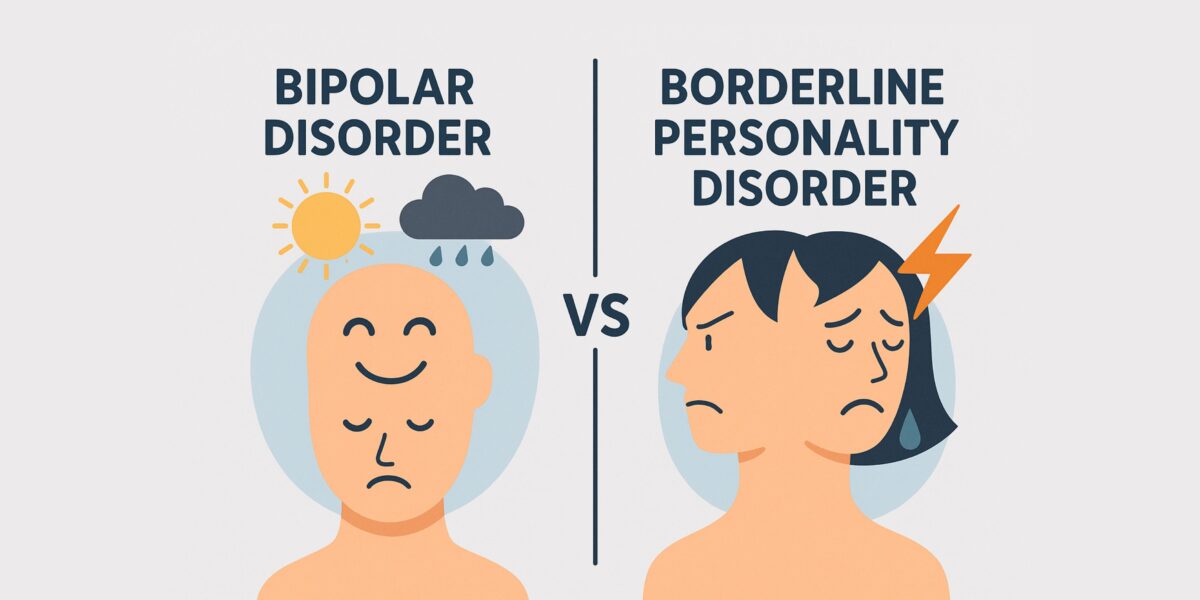Borderline personality disorder was named as such because certain patients with symptoms similar to psychosis and mania seemed to be right on the borderline of other conditions as well. But they did not fit the diagnosis of either schizophrenia or bipolar disorder.
This shows us how certain mental conditions might initially appear to be very similar. But they could differ widely in nature.
Bipolar disorder (BD) and borderline personality disorder (BPD) are two serious mental health conditions sharing some common symptoms. However, their development, manifestation in day-to-day life, and approach to treatment are all very different.
In this article, I’ll attempt to distinguish the two in plain language.
Defining Bipolar and Borderline Personality Disorder
What is Bipolar Disorder?
Bipolar disorders are a classification of mood disorders, which are a class of syndromes that also include depression.
People with this (these) disorder(s) experience extreme highs (also known as mania or hypomania) and lows (sometimes known as depression).
Days or even weeks may pass during these bouts. It could also be that they maintain a steady psychological state between them.
There are two main types:
- Bipolar I: Full-blown manic episodes and usually depression too.
- Bipolar II: Milder mania (called hypomania) and more frequent depression.
There are further subclassifications of bipolar disorders including cyclothymia.
These further types do not meet the criteria of the first two classic presentations of bipolar – however, they also feature distinct ‘poles’ of moods, for multiple days.
What is Borderline Personality Disorder?
In contrast, borderline personality disorder (BPD) entails severe issues with an individual’s personality. Personality disorders influence a person’s long-term thoughts, emotions, and social interactions. The person who has BPD experiences intense emotions, impulsive conduct, fear of abandonment, and unstable relationships. Their emotions can change abruptly, sometimes in a matter of hours.
The Diagnostic and Statistical Manual for Psychiatric Disorders denotes the presence of any of the following five features to constitute borderline personality disorder:
- Frantic efforts to avoid real or imagined abandonment.
- A pattern of unstable and intense interpersonal relationships characterized by alternating between extremes of idealization and devaluation (also called “splitting”).
- Identity disturbance: markedly and persistently unstable self-image or sense of self.
- Impulsivity in at least two areas that are potentially self-damaging, such as spending, sex, substance abuse, reckless driving, or binge eating.
- Recurrent suicidal behavior, gestures, or threats, or self-mutilating behavior.
- Affective instability due to a marked reactivity of mood (e.g., intense episodic dysphoria, irritability, or anxiety usually lasting a few hours and only rarely more than a few days).
- Chronic feelings of emptiness.
- Inappropriate, intense anger or difficulty controlling anger (e.g., frequent displays of temper, constant anger, recurrent physical fights).
- Transient, stress-related paranoid ideation or severe dissociative symptoms.
The core feature of this disorder is severe emotional dysregulation paired with interpersonal conflict.
Having defined both conditions, let’s start comparing the two!
Comparing the Symptoms of Bipolar Disorder and Borderline Personality Disorder
Mood Swings: Length and Intensity
The duration of mood swings is one significant difference. Mood swings in bipolar disorders can linger for days, weeks, or even longer. These changes may not be connected to particular life events and frequently occur for no apparent cause.
Emotional changes in BPD can occur quickly, intensely, and even hourly. Usually conversations or stressful situations—especially in intimate relationships—cause these alterations.
Triggers for Emotional Changes
Episodes of bipolar mood frequently appear to occur suddenly. Even if living conditions haven’t altered, a person may experience a sudden manic episode or shift from feeling relatively bad to extremely miserable. Having said that, there is evidence to suggest that stress is linked to triggering mood episodes in bipolar. However, the shift in behavior is quite pronounced.
Mood swings associated with BPD typically occur in response to interpersonal conflicts, such as feeling abandoned, neglected, or rejected. These feelings are frequently connected to problems in relationships or disputes.
Identity and Self-Image
A fragile sense of self is a common problem for people with borderline personality disorder. Depending on who they’re with or how they’re feeling at the time, their perception of themselves may alter.
Bipolar disorder, on the other hand, often has less of an impact on a person’s fundamental sense of self.
People with BD often have a more consistent self-perception, even during mood swings. This does not mean that they experience stable or healthy psychological states during mania, hypomania or depression. However, it does mean that their view of themselves does not fluctuate drastically within a very short span of time.
Impulsivity and Risky Behavior
Impulsivity is a feature of both illnesses.
However, their causes differ.
Impulsive behaviors, such as binge eating, shopping sprees, or hazardous sex, are frequently caused by emotional discomfort or a fear of being alone in people with BPD.
This is different in the case of episodes in a bipolar disorder.
Risky conduct typically manifests during manic or hypomanic episodes in bipolar disorder. This might involve extravagant spending, careless driving, or lofty goals that don’t seem grounded in reality.
Relationship Patterns
Relationships that are passionate and turbulent are common for people with BPD. Their dread of being abandoned might cause them to abruptly go between idealizing and depreciating someone.
Usually, bipolar illness does not include such dramatic patterns of relationships. Relationship issues typically result from mood swings rather than persistent patterns of emotional instability.
Family History and Root Causes
There is often a larger hereditary component to bipolar illness. Your risk is increased if you have a close relative with BD. It is also thought to have a biological foundation in the chemistry of the brain.
Contrarily, early life events including childhood trauma, abuse, or neglect are more frequently connected to BPD. It is thought to have a more developmental and environmental basis.
Diagnosis and Assessment
Mental health professionals use structured interviews and screening tools to tell the difference. Key things they look for include:
- Length of mood shifts
- Presence of triggers
- Personal and family history
- Sense of self and relationship patterns
Getting the right diagnosis matters because the treatment plans are so different.
While diagnosing borderline personality disorder, a clinician would confirm whether their symptoms began earlier in life (usually during adolescence), continued for a significant number of years, and continue to persist.
On the other hand, in diagnosing a bipolar disorder, the clinician usually checks whether the individual has had a history of mania, hypomania or elongated time periods (at least a few days) of a significant mood episode.
More specifically, clinicians look for the presence of an elevated or expansive mood for a diagnosis of a bipolar disorder.
Treatment Approaches
Typically, mood stabilizers, antidepressants, and antipsychotics are used to treat bipolar disorder. Additionally, therapy can be beneficial, particularly when learning how to control triggers and avoid relapse.
Therapy, particularly Dialectical Behavior Therapy (DBT), is the main treatment for borderline personality disorder. DBT teaches people how to control strong emotions, enhance interpersonal connections, and lessen self-destructive behaviors. Although it’s not the primary emphasis, medication may be used.
A combination strategy—medication and therapy—is frequently the most successful when a person has both illnesses.
Final Thoughts
Although emotional ups and downs are a feature of both bipolar illness and borderline personality disorder, their causes and types of care differ.
The good news?
Those who have either (or both) can still live stable, fulfilling lives with the correct diagnosis and a good treatment plan.
A wonderful first step if you or someone you care about is experiencing severe emotions or mood swings is to get help from a mental health expert.
I am a Clinical Psychologist and a Lecturer of Psychology at Government College, Renala Khurd. Currently, I teach undergraduate students in the morning and practice psychotherapy later in the day. On the side, I conjointly run Psychologus and write regularly on topics related to psychology, business and philosophy. I enjoy practicing and provide consultation for mental disorders, organizational problems, social issues and marketing strategies.





